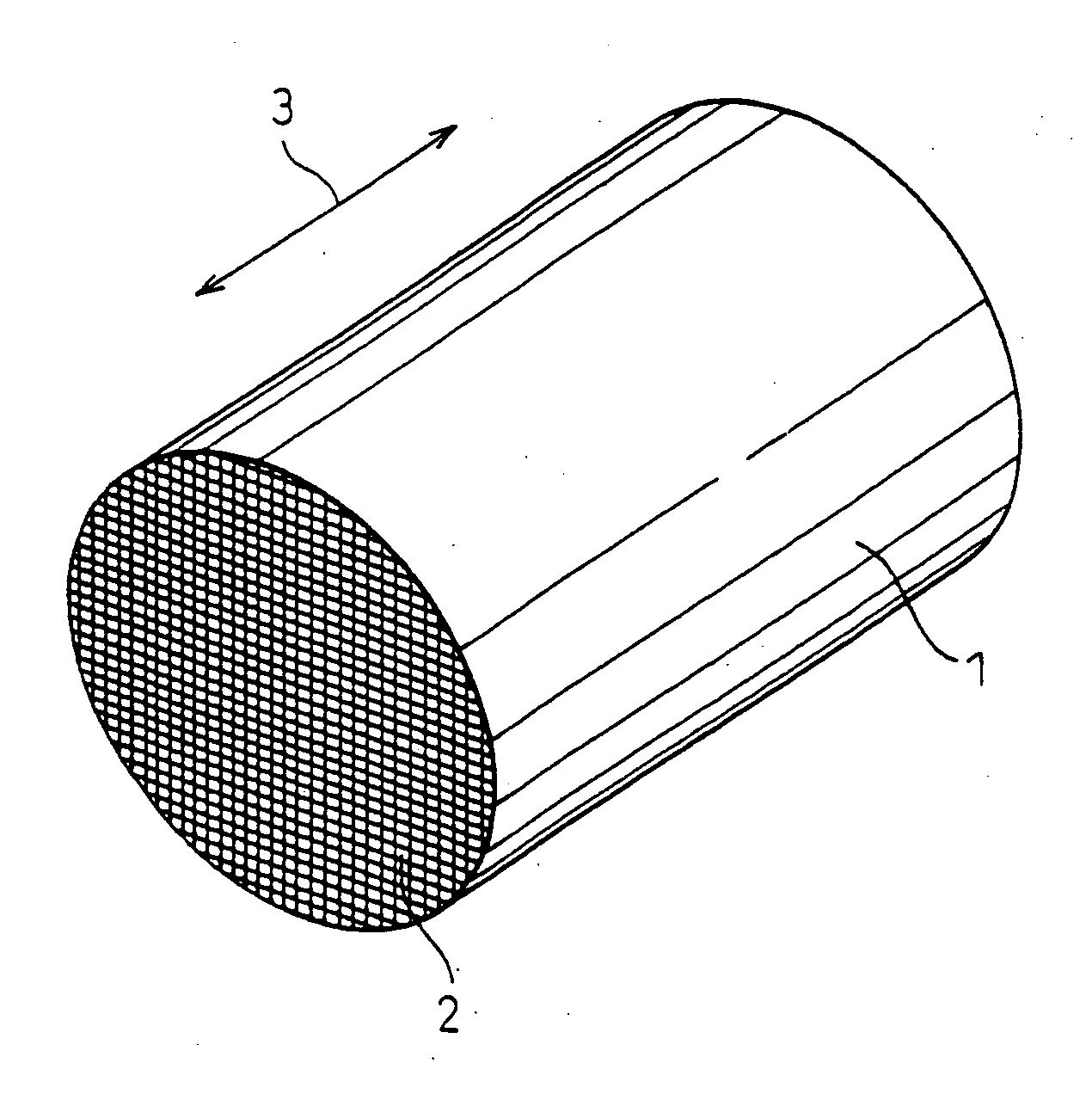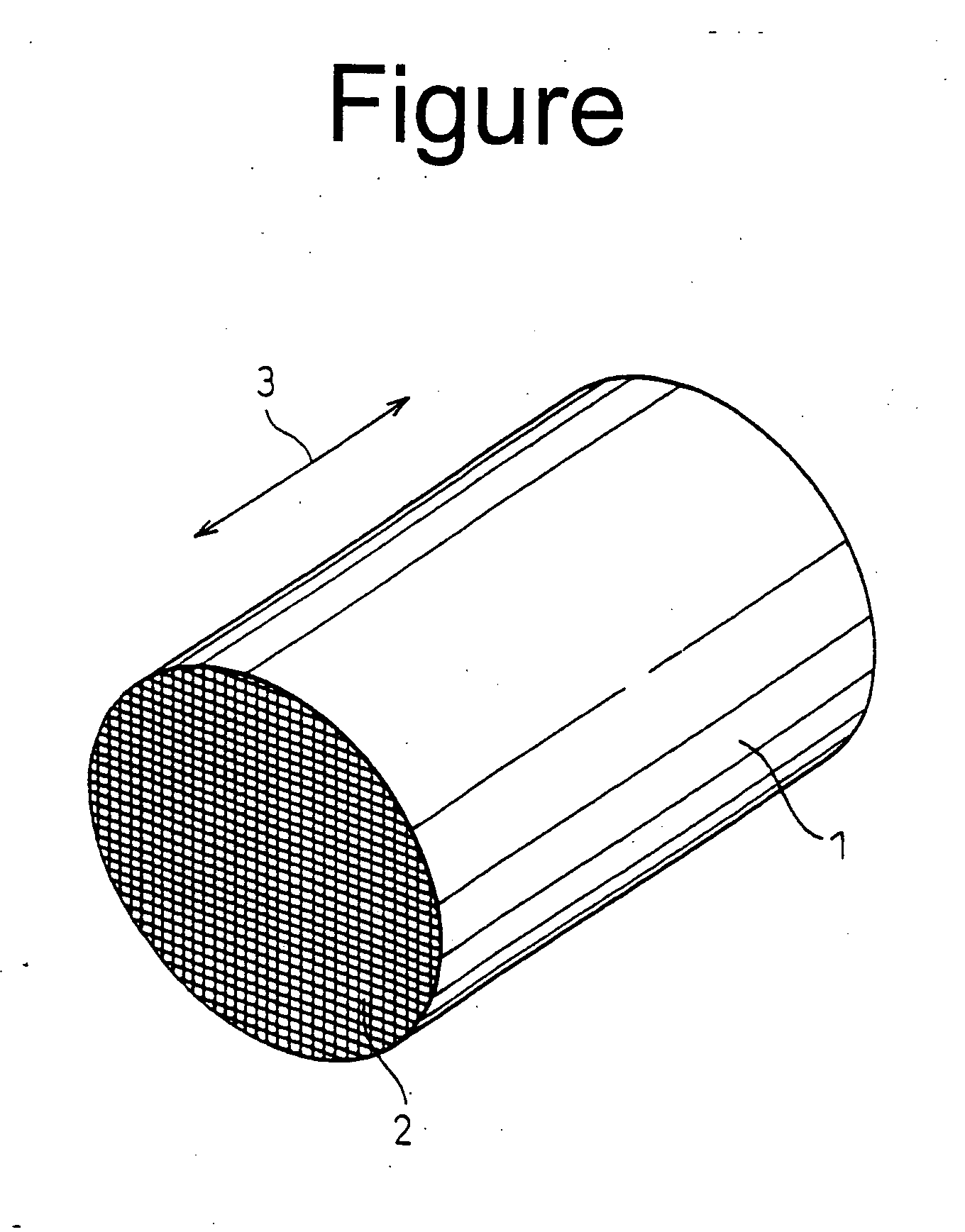Ceramic support capable of supporting a catalyst, a catalyst-ceramic body and processes for producing same
a ceramic support and catalyst technology, applied in the direction of catalyst activation/preparation, metal/metal-hydroxide catalysts, chemical/physical processes, etc., can solve the problem of reducing the thermal capacity of the honeycomb structure as a whole, disadvantageously reducing the strength of the cordierite honeycomb structure, and reducing the amount of catalyst components. , to achieve the effect of low pressure loss, low thermal capacity and high thermal shock resistan
- Summary
- Abstract
- Description
- Claims
- Application Information
AI Technical Summary
Benefits of technology
Problems solved by technology
Method used
Image
Examples
example 1
[0061] In Example 1, as the cordierite materials, talc, kaolin, alumina and aluminium hydroxide were used and formulated into a near theoretical cordierite composition. The cordierite materials were added with appropriate amounts of a binder, a lubricant and a humidicant, kneaded to a clay-like material and extruded to form a honeycomb shape having a cell wall thickness of 100 μm, a cell density of 400 cpsi (cells per square inch) and a diameter of 50 mm. The honeycomb shape was dried by heating, in air, up to 800° C. to remove the binder, and then fired by reducing the pressure to 6.7×10−4 Pa (5×10−6 Torr) and keeping the honeycomb shape under that pressure at 1390° C. for 2 hours, to obtain a honeycomb structure.
[0062] The obtained honeycomb structure was evaluated in the oxygen content of the honeycomb structure, the number of oxygen contained in the unit lattice of the cordierite crystal, the lattice constant of the b0 axis of the cordierite crystal, the amount of Pt supported ...
example 2
[0074] The same cordierite materials as in Example 1 was formed into a honeycomb shape, heated to remove a binder and then fired in a hydrogen atmosphere as a reducing atmosphere at 1390° C. for 2 hours.
[0075] The obtained honeycomb structure was evaluated in the same manner as in Example 1 and the results are also shown in Table 1.
[0076] It is clear from Table 1 that in comparison with Comparative Example 1, the cordierite honeycomb structure fired in a reducing atmosphere in Example 1 had a reduced content of the honeycomb structure, a reduced amount of oxygen contained in the unit lattice of the cordierite crystal, and a smaller lattice constant of the b0 axis of the cordierite crystal. It is therefore clear that oxygen left the cordierite crystals and oxygen vacancies were formed. When Pt was supported on the cordierite honeycomb structure, the amount of the Pt supported was 1.14 g / l in the case of water used as the solvent and 14.81 g / l in the case of ethanol used as the solv...
examples 6 to 10
[0086] In Examples 6 to 8, cordierite honeycomb structures were produced in the same manner as in Examples 3 to 5, except that the used firing atmosphere was a reduced pressure atmosphere having a pressure of 6.7 to 10−4 Pa (5×10−6 Torr).
[0087] In Examples 9 and 10, cordierite honeycomb structures were produced in the same manner as in Example 5, except that the used firing atmosphere was a hydrogen atmosphere as a reducing atmosphere.
[0088] The obtained cordierite honeycomb structures were evaluated in the same manner as in Example 1. The results are also shown in Table 2.
[0089] As seen in Table 2, in comparison with Comparative Examples 2 to 7, the cordierite honeycomb structures produced in Examples 6 to 10 had a reduced oxygen content of the honeycomb structure, a reduced number of the oxygen contained in the unit lattice of the cordierite crystal, and a smaller lattice constant of the b0 axis of the cordierite crystal. It is therefore clear that oxygen vacancies were formed....
PUM
| Property | Measurement | Unit |
|---|---|---|
| width | aaaaa | aaaaa |
| average distance | aaaaa | aaaaa |
| distance | aaaaa | aaaaa |
Abstract
Description
Claims
Application Information
 Login to View More
Login to View More - R&D
- Intellectual Property
- Life Sciences
- Materials
- Tech Scout
- Unparalleled Data Quality
- Higher Quality Content
- 60% Fewer Hallucinations
Browse by: Latest US Patents, China's latest patents, Technical Efficacy Thesaurus, Application Domain, Technology Topic, Popular Technical Reports.
© 2025 PatSnap. All rights reserved.Legal|Privacy policy|Modern Slavery Act Transparency Statement|Sitemap|About US| Contact US: help@patsnap.com



